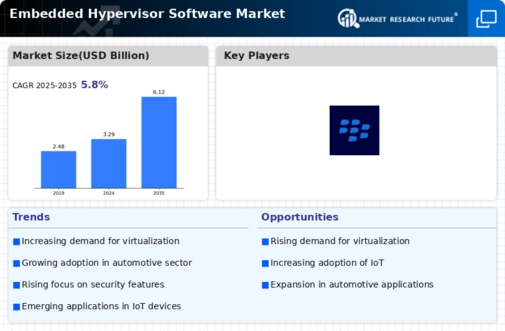Top Industry Leaders in the Embedded Hypervisor Software Market

Competitive Landscape of Embedded Hypervisor Software Market:
The embedded hypervisor software market is anticipated to witness significant growth over the coming years, driven by the rising demand for multi-core embedded systems and the need for system consolidation, security, and improved software development capabilities. This market is fiercely competitive, featuring established multinational companies, domestic brands, and emerging players.
Key Players:
- Oracle Corporation (U.S.)
- Microsoft Corporation (U.S.)
- IBM Corporation (U.S.)
- Mentor Graphics Corporation (U.S.)
- Blackberry (Canada)
- SYSGO AG (Germany)
- Sierraware LLC (U.S.)
- Citrix Systems Inc (U.S.)
- Red Hat Inc (U.S.)
Strategies Adopted:
Key players are adopting various strategies to gain a competitive edge in the market:
- Focus on specific market segments: Companies are focusing on specific market segments, such as automotive, aerospace, and industrial automation, due to their high growth potential.
- Strategic partnerships: Collaborations with hardware manufacturers and software vendors are common to offer integrated solutions and expand market reach.
- Open-source contributions: Contributing to open-source hypervisor projects helps build a strong community and attract new users.
- Continuous innovation: Companies are constantly investing in research and development to offer advanced features and improve performance.
- M&A activity: Mergers and acquisitions are another strategy to acquire new technologies and expand product portfolios.
Factors for Market Share Analysis:
Several factors influence a company's market share in the embedded hypervisor software market:
- Product portfolio: The breadth and depth of hypervisor offerings cater to different market segments and application needs.
- Technology leadership: Companies with innovative features and high performance attract leading customers.
- Brand reputation: A strong brand reputation and track record in specific markets build trust and loyalty.
- Global reach: A strong presence in key regions and distribution channels ensures broad market access.
- Pricing strategy: Competitive pricing strategies attract price-sensitive customers and increase market penetration.
- Customer service: Providing excellent customer support and technical assistance is crucial for customer retention and satisfaction.
New and Emerging Companies:
Several new and emerging companies are entering the market with innovative solutions, challenging established players:
- SYSGO: Provides the PikeOS hypervisor and other software solutions for mixed-criticality systems.
- NXP Semiconductors: Offers the SafeAssure hypervisor specifically designed for NXP processors.
- Mentor Graphics (now Siemens EDA): Provides the Nucleus RTOS with hypervisor capabilities, targeting resource-constrained systems.
Current Company Investment Trends:
Companies are investing heavily in the following areas:
- Security: Enhancing security features to address growing cybersecurity threats in embedded systems.
- Virtualization for mixed-criticality systems: Enabling the coexistence of different criticality levels on the same hardware.
- Artificial intelligence and machine learning (AI/ML): Integrating AI/ML capabilities into hypervisors for real-time decision making and optimization.
- Cloud-native development: Building hypervisors designed for cloud-based deployments and edge computing.
- Open-source technologies: Contributing to open-source projects to accelerate innovation and collaboration.
Latest Company Updates:
The QNX® Academy for Functional Safety, a comprehensive online programme for software developer enablement that will be launched in 2023 by BlackBerry Limited and Texas Instruments, aims to accelerate software innovation efforts and reduce risk in the process of creating safe and secure embedded systems.
The Linux Foundation-hosted open source hypervisor The Xen Project today announced the release of Xen Project Hypervisor 4.17 in 2022. This version adds a number of features that enable safety certification, static partitioning of embedded devices, improved device pass-through reliability, increased performance, and enhanced security. This most recent version was made possible by the vibrant Xen Project community, which included developers from a wide spectrum of businesses and organisations.

